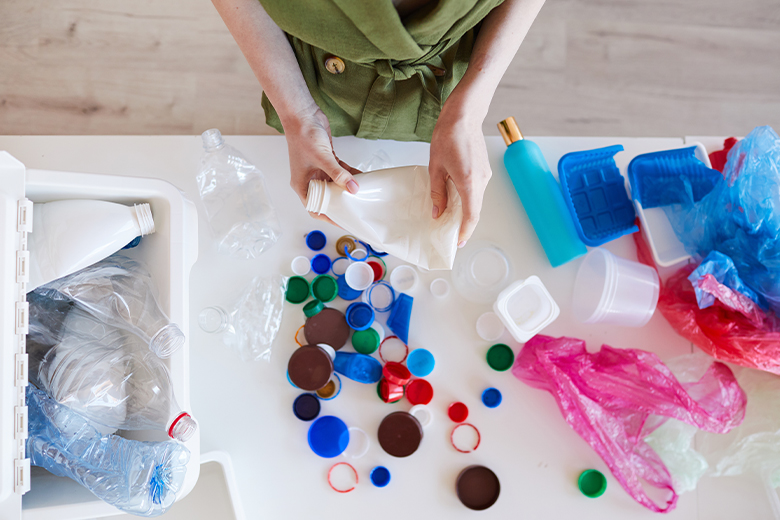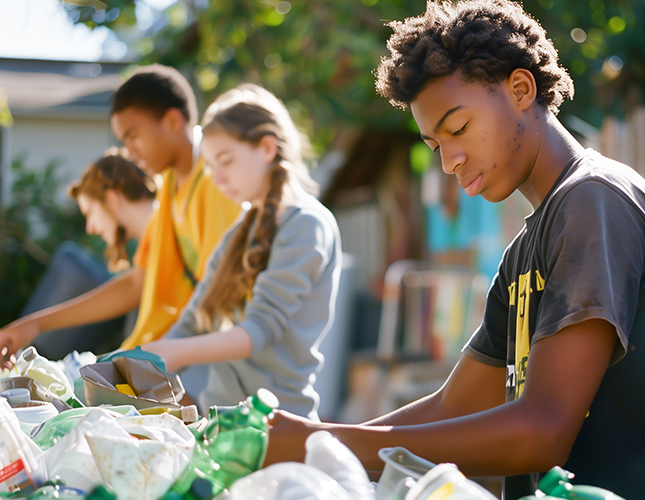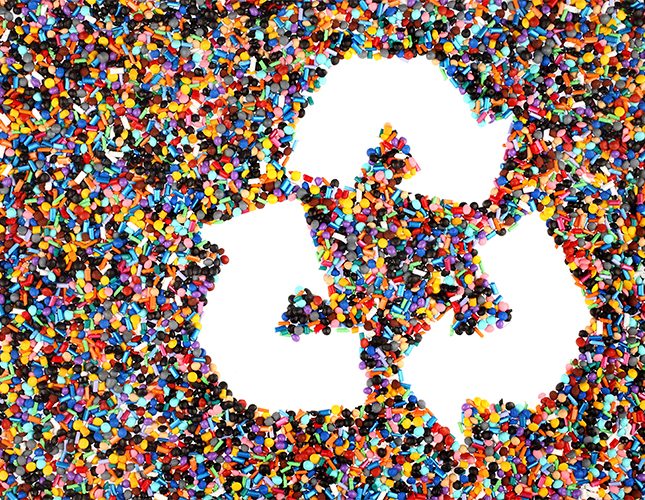The different types of plastic and their recyclability rate.
Just because there’s the recycling logo on the bottom of your plastic cup doesn’t mean it’s really recyclable. Some plastics are fully recyclable and others have toxic components, making the recycling process more complicated.
There are 7 kinds of plastic, each identified by a number inscribed in the Möbius ribbon, the symbol of recycling. This codification allows consumers to know whether the type of plastic they have in their hands is recyclable or not, but it is still necessary to know it! We explain one by one, the different types of plastic and their recyclability rate.

PET: Polyethylene terephthalate
Plastic #1 is made from polyethylene terephthalate and is commonly known as PET.
This transparent plastic is most often used for bottles of water, soft drink, fruit juice or vegetable oil, peanut butter jars, egg containers, disposable packaging, food trays.
It is considered ecological plastic. Indeed, to manufacture it requires little electricity (480°F versus 1830°F for glass, for example), but it does require petroleum products, which negates the ecological aspect!
This plastic has very little heat resistance. PET is porous, allowing bad bacteria to accumulate and develop. This is why it is not recommended to use a plastic bottle for a long time.
PET is 100% recyclable, and there are many outlets (bottles, polyester fibres, thermoformed egg containers, etc.).
HDPE: High Density Polyethylene
Plastic #2 is high density polyethylene and is commonly used with the abbreviation HDPE. Polyethylene is generally used to make laundry bottles, milk bottles, ice cream jars and toys. It is a thermoplastic that is hard and opaque, and it is easily recyclable.
It is the plastic resin most sought after by recyclers, according to Recyc-Québec. As HDPE is the king plastic for food packaging, there are many recycling outlets and it can be used to make new containers, jars, bottles or tubes.
PVC: polyvinyl chloride
You’ve probably heard of PVC. Plastic #3 is polyvinyl chloride and is used to make a number of household items such as shower curtains, vinyl, plastic film, inflatables such as pool toys, flooring, car interiors and plenty of vegan leathers.
It is one of the most dangerous types of plastics for health and the environment, because for its manufacture, we add a lot of plasticizers and phthalates to make it more flexible, and these chemicals can migrate into food more easily than other plastics. To avoid phthalates, Health Canada recommends choosing products that are labelled as free from polyvinyl chloride.
Because of the presence of many additives, this plastic is not recyclable in most cities. Check with your ecocentre to find out if it accepts PVC containers.
The PEbd: Low density polyethylene
Plastic #4 is a low density polyethylene known as Pebd. It is most often used for grocery bags, frozen food bags, garbage bags, transparent kitchen paper, waterproof interior covering of coffee cups and milk cartons.
It is a thermoplastic made from petroleum. It can be opaque or translucent. Although there are no known health problems, this plastic is very difficult to recycle. There are currently few recycling facilities for this type of plastic, which is the nightmare of sorting centres, because by stretching, they can contaminate other materials, as well as cause equipment breakdowns.
PP: Polypropylene
Plastic #5 is polypropylene most often seen with the abbreviation PP.
PP is transparent and most often used for jars such as yogurt, cheese and butter, lunch boxes, medicine bottles, bottles, clear containers for prepared foods.
It is a thermoplastic polymer that makes it strong and heat resistant. This is why we often consider this plastic to be suitable for use in the microwave and dishwasher.
It is one of the safest plastics and can be recycled several times before reaching the end of its life. Recycled, it will be used to make brushes, cables, panels, trays or gardening equipment.
The PS: Polystyrene
Plastic #6 is polystyrene, abbreviated PS. It is a petroleum-based plastic, used for many other items such as disposable cutlery, coffee cup lids, polystyrene egg cups and cartons, DVD cases, take-out trays and peanut packaging.
Polystyrene is used for its insulating properties (keeps your coffee warm, but also your home, when it is integrated into building materials). Paradoxically, it is a polymer that does not resist heat. At high temperatures, it releases styrene, a toxic substance. In addition, it is a type of plastic that easily breaks into small pieces which pollutes waterways.
It is not generally accepted at recycling facilities, as is the city of Montreal, which does not accept number 6 plastics in the collection. Industrial recycling processes are not very developed and there are few outlets. When you see vegetables packaged with a transparent film, it’s doubly negative!
In short, it is a plastic to avoid to the maximum since, for the moment, it ends its life at the landfill, for lack of means to reuse it.
Other types of plastics:
Many plastics fall into this category of #7 plastic, so their characteristics vary by material type. Among them: polycarbonate (PC), epoxy resins, teflon (PTFE), melamine or the rubber family (latex, neoprene foam).
They are found in water cylinders (CPs), interior coating of food cans (epoxy resins), stoves, pots and pans (teflon), crockery (melamine), baby pacifiers and pacifiers (natural and synthetic rubbers).
Polycarbonate has been removed from many products that come into contact with food or water (water bottles), as it contains bisphenol A, a recognized endocrine disruptor.
No. 7 plastic is very little recycled, especially due to the high presence of additives.









